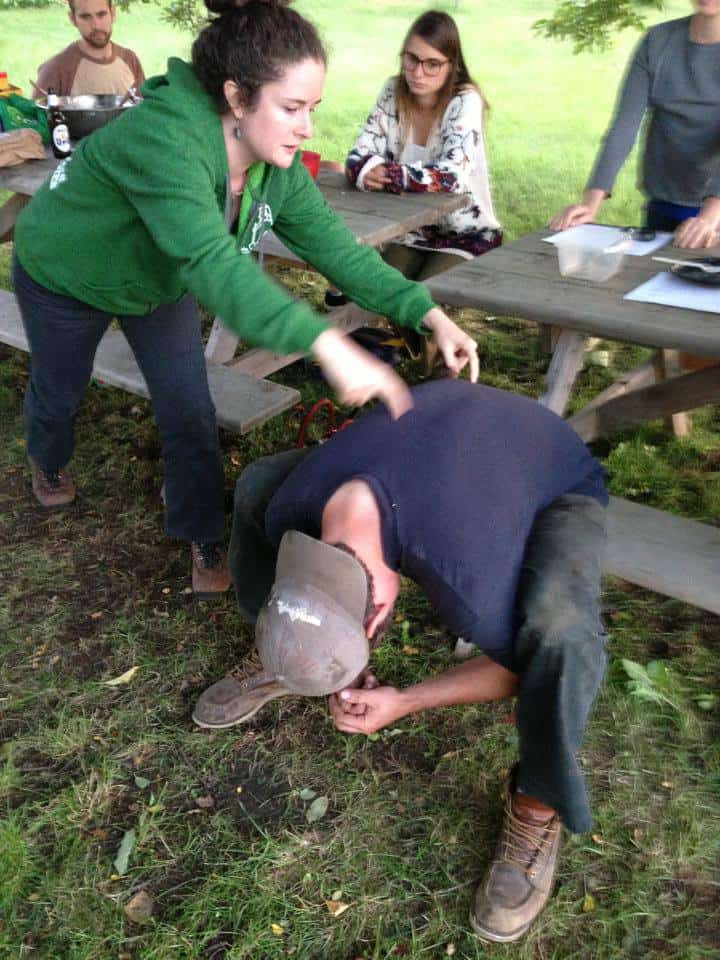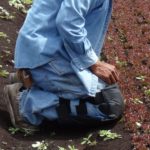Farm Work and Your Health
Summer on the farm a healthy place to be, but avoid pushing your body to the limit.
by Marybeth Vargha
I remember friends from Philadelphia coming up to visit our farm for the first time. They eagerly wanted the work experience. It didn’t take long during a weeding session for someone to say, “This is such back breaking work.” I responded, “No, I see it as back building.” I liked the exercise in the fresh air that actually resulted in healthy food for people. What I didn’t let on was that there were back breaking activities that could really cause permanent damage.
Living in our rural neighborhood you become adept at recognizing a farmer. He can be all dressed up, but there is something in the walk and posture that is peculiar to years working on tractors and hauling heavy stuff. There is a sort of forward lean and bowed legs that work stiffly, the muscled and callused hands that don’t quite make a fist, and no matter what the weather, they don’t ever run, just keep going at their same pace without ever stopping.
The work is harsh on our bodies, and without taking some time to figure out better ways of doing things you’ll be straining your back and stiffening your joints. Injury prevention comes in stages: learn what it means to have a fully functioning body, know the best way to move your body to avoid extra stresses, evaluate the work to look at ways to prevent unnecessary strains, and give yourself the time for restoration of your body after a hard day of work. Here are some tips to consider:
Know the difference between back breaking and back strengthening work. Raking, hoeing, shoveling activities that use your back muscles are good for strengthening. Lifting heavy objects, sitting on machinery too long, and other work that cause trauma to your bones and joints will be ‘back breaking’.

Lydia Sivel-Irons conducting ‘The Working Body’ workshop for farmers.
Safe lifting. If you don’t remember this from your early years, let’s review it – lift heavy objects using your legs with a straight back, slightly bent knees, and arms close to your torso (or also known as “ass in the grass, eyes on the sky”). You can’t do this with a bend in your back or twist at the waist. Keep reminding yourself to do this until it becomes second nature.
Work within your limitations. Yeah, you might be able to carry two bins full of zucchini, but walking on uneven ground in the mud with the equivalent of 100 lb free weights is foolish. Think through the engineering solution that works on your farm. Use a cart, wagon, wheel barrow, pull-behind trailer, or anything that will fit through your rows, hold lots of weight and not get stuck in the mud.
Think of ergonomic solutions at each work place. If the potting bench is too low, get a stack of flats under what you’re seeding to eliminate the shoulder and back stress. Make sure you don’t need to lift or move washing tubs by designing easy filling/draining systems. Use the right size tool. Don’t skimp on cheap gloves; if they cause problems, you’ll likely not wear them.
A research project being conducted at New York Center for Agricultural Medicine and Health (NYCAMH) is a community collaboration with farm workers in the Black Dirt region of New York to design a better knee pad. You know the problem – there isn’t a knee pad on the market that works for farmers in the field. They’re either too stiff, keep slipping down, too thin or just darn impossibly to wear when you are getting up and down weeding that 200 foot row of mesclun. The design that looks most promising uses a material much like parachutes (tough and light) with some padding, it is easily adjusted by Velcro straps above and below the knee, is longer to cover more of the upper shin, and is very flexible. Small stones and dirt can still get underneath the pad, but it is a great design and easy to make yourself.

Prepare for the work. Consider yourself an athlete doing the decathlon. No coach would let you start without your warm-ups. http://www.theflexiblefarmer.com offers a booklet “The Working Body” which explains body mechanics and which stretches are best to help prepare your muscles and joints for the work at hand. These warm-ups open up the joints, get the blood flowing to the right muscles and strengthen your postures.
Limit time on tractors. Research on whole-body vibration (WBV) has concluded that there are health risks associated with exposure to the vibrations on tractors over longer periods of time. Some types of tractor work produce more vibrations and shocks to the body, which can cause back troubles or even damaging resonations to the body’s organs. If your tractor has excessive vibration, try to fix the cause or install a better seat to absorb some of it. Consider taking more breaks to stretch and recover or switch people between jobs. This can also be true when you use walk-behind equipment.
No matter what, you probably will experience aches and pains. Farmers are likely to just live with pain and keep working. You have to be aware that some pain can be signs of serious trauma to your joints and muscles which won’t readily heal on its own, and long term pains can be signs of serious permanent damage that will limit your future wellbeing.
The most common complaint is lower back pain. Doctors find that the most common causes for the pain are spinal stenosis (a condition in which the spinal canal becomes narrow leading pinched nerves and to being stooped over to reduce the pain), a bulging or ruptured disc (the discs themselves are painful), inflamed facet joints (those joints that give your back flexibility) and back muscle spasms. Treatment for these conditions varies greatly, so if pain persists it’s best to get the diagnosis before experimenting with home remedies.
Restorative hydration. Find ways to keep drinking. Farmers can stay outside for hours without eating but you can’t stay healthy without drinking. Keep water bottles at spigots, in the vehicles, in the greenhouse and just keep refilling. No room on the tractor? Put your water, snacks, long sleeve shirt, bandanas and first aid kit in a backpack you wear or slip over something.
I was reading the article “Are you cool enough to drink Switchel?” last fall in Modern Farmer and just had to smile. Some smart guys are bottling switchel and marketing it to yoga hipsters in the city – what a great business plan! Switchel (aka Whomp) is a traditional drink that many older generation farmers know about. You fill a large bottle with a combination of mostly water, a little apple cider vinegar, ginger, some baking soda and a sweetener if you like (maple syrup works). This hydration includes electrolytes to keep your body hydrated. Keep a bottle with you on the tractor or in the truck whenever you’re out in the fields. An extra container of water is especially important to have to soak your bandana, hat or shirt to cool down the blood when you’ve been in the sun. We’re lucky to have a stream along the fields, so a quick dip every few hours is a great blessing.

Kneepad design from Community Collaboration research project at NYCAMH.
A handy resource to have out in the field is the OSHA Heat Safety Tool. It is a free download for Android at Google play or at the iTunes store. This app will download local weather data and calculate the heat index, show you the current risk level, give you information on precautions, how to recognize signs of heat illness and what to do for first aid.
Allow your body some restoration, but don’t wait until winter. Each day give your body the rest it needs for your muscles and joints to recover. If you feel some symptoms of strain, use an ice pack for 5-10 minutes to reduce any inflammation and then follow with a hot water bottle or hot shower to increase the blood flow into the muscles. Get a good rest so you can get up and do it all over again tomorrow!
Marybeth Vargha is a member of the Outreach Team of the New York Center for Agricultural Medicine and Health (NYCAMH) in Cooperstown, NY. She also works with her husband on Big Sky Farms in Westford, NY. Contact her at marybeth.vargha@bassett.org.
For more information about NYCAMH services for your farm or community, go to www.NYCAMH.org or call (607)547-6023.


I found it interesting how you mentioned how you should know the difference between backbreaking and back strengthening work and how you should do more back strengthening work. My wife and I are in the process of moving to a ranch and I want to make sure I can operate it for long enough to eventually give it to my son. I will be sure to keep this in mind so I don’t get carelessly injured while working!